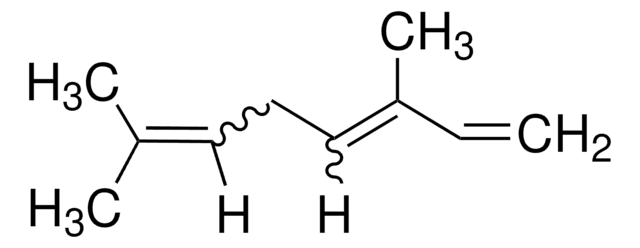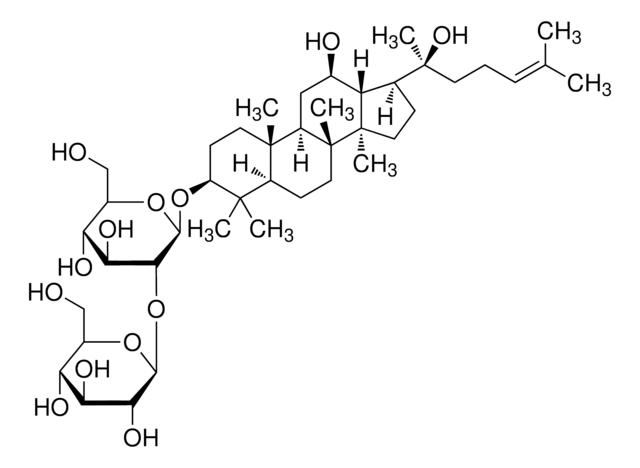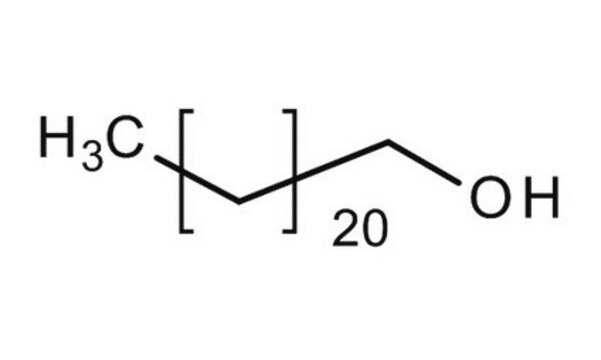T3777
1-Triacontanol
≥98% (capillary GC)
Sinonimo/i:
1-Hydroxytriacontane, Melissyl alcohol
Autenticatiper visualizzare i prezzi riservati alla tua organizzazione & contrattuali
About This Item
Formula condensata:
CH3(CH2)28CH2OH
Numero CAS:
Peso molecolare:
438.81
Beilstein:
1711965
Numero CE:
Numero MDL:
Codice UNSPSC:
12352104
ID PubChem:
NACRES:
NA.25
Prodotti consigliati
Saggio
≥98% (capillary GC)
Stato
powder
Punto di fusione
86-87 °C (lit.)
Temperatura di conservazione
2-8°C
Stringa SMILE
CCCCCCCCCCCCCCCCCCCCCCCCCCCCCCO
InChI
1S/C30H62O/c1-2-3-4-5-6-7-8-9-10-11-12-13-14-15-16-17-18-19-20-21-22-23-24-25-26-27-28-29-30-31/h31H,2-30H2,1H3
REZQBEBOWJAQKS-UHFFFAOYSA-N
Cerchi prodotti simili? Visita Guida al confronto tra prodotti
Applicazioni
- The Relationships between Waxes and Storage Quality Indexes of Fruits of Three Plum Cultivars.: This study examines how 1-Triacontanol affects the storage and quality of plums. By analyzing waxes that include 1-Triacontanol, the research helps understand its impact on extending the shelf life of fruits, which is crucial for agricultural economics and food sustainability (Zhu et al., 2023).
- Mitigation of salt stress in Indian mustard (Brassica juncea L.) by the application of triacontanol and hydrogen sulfide.: This research explores the use of 1-Triacontanol to alleviate salt stress in Indian mustard plants, offering insights into how it enhances plant growth under stress conditions. Such studies are vital for improving crop resilience to environmental stresses, thus contributing to sustainable agriculture practices (Verma et al., 2023).
- The Effect of the Stress-Signalling Mediator Triacontanol on Biochemical and Physiological Modifications in Dracocephalum forrestii Culture.: The study delves into how 1-Triacontanol acts as a stress mediator in plant cultures, highlighting its potential to induce biochemical and physiological changes that could lead to enhanced secondary metabolite production in medicinal plants (Weremczuk-Jezyna et al., 2022).
- Triacontanol priming as a smart strategy to attenuate lead toxicity in Brassica oleracea L.: This investigation shows the effectiveness of 1-Triacontanol in mitigating lead toxicity in plants, providing a strategy to protect crops from heavy metal contamination, thereby ensuring food safety and environmental health (Ahmed et al., 2023).
Codice della classe di stoccaggio
11 - Combustible Solids
Classe di pericolosità dell'acqua (WGK)
nwg
Punto d’infiammabilità (°F)
Not applicable
Punto d’infiammabilità (°C)
Not applicable
Dispositivi di protezione individuale
Eyeshields, Gloves, type N95 (US)
Scegli una delle versioni più recenti:
Possiedi già questo prodotto?
I documenti relativi ai prodotti acquistati recentemente sono disponibili nell’Archivio dei documenti.
I clienti hanno visto anche
M K Akitha Devi et al.
Indian journal of experimental biology, 50(10), 729-734 (2012-12-12)
Development of a reproducible, versatile and efficient in vitro plant regeneration system is highly warranted for Indian soybean varieties for their mass multiplication in view of their commercial significance. Accordingly a protocol for direct shoot organogenesis in soybean variety JS
Shijie Du et al.
Natural product research, 23(14), 1316-1321 (2009-09-08)
A new lactone was isolated from the leaves of Xylocarpus granatum, along with three known compounds: triacontanol, beta-sitosterol and kaempferol-3-O-beta-D-glucoside. Its structure was elucidated as 3-(1-hydroxyethyl)-4,4-dimethyl-4-butyrolactone (1) by infrared, (1)H and (13)C NMR and ESI-MS data. At a concentration of
Xiao-Dong Jia et al.
Zhong yao cai = Zhongyaocai = Journal of Chinese medicinal materials, 31(7), 988-990 (2008-11-01)
To study the chemical constituents of flower buds of Lonicera macranthoides. The 90% EtOH extract of Lonicera macranthoides. was successively partitioned with petroleum ether and ethyl acetete. Repeated column chromatography of the ethyl acetete fraction afforded the following compounds (1-9):
Muhammad Arif Lodhi et al.
Natural product research, 21(8), 721-725 (2007-07-10)
The mechanism of inhibition of jack bean and Bacillus pasteurii ureases was investigated by triacontanyl palmitate (1) which is a long-chain fatty ester and has been isolated from Symplocos racemosa Roxb. Lineweaver-Burk, Dixon plots, and their secondary replots showed that
Krishnamurthy Ramanarayan et al.
Journal of plant physiology, 161(4), 489-492 (2004-05-07)
Triacontanol (TRIA), a long chain aliphatic alcohol (C30H61OH) reverses the effect of jasmonic acid (JA) in inducing proteinase inhibitors (PIs) in tomato leaves. Porcine pancreas trypsin and Spodoptera litura gut proteinases were inhibited in the presence of leaf proteins treated
Il team dei nostri ricercatori vanta grande esperienza in tutte le aree della ricerca quali Life Science, scienza dei materiali, sintesi chimica, cromatografia, discipline analitiche, ecc..
Contatta l'Assistenza Tecnica.











